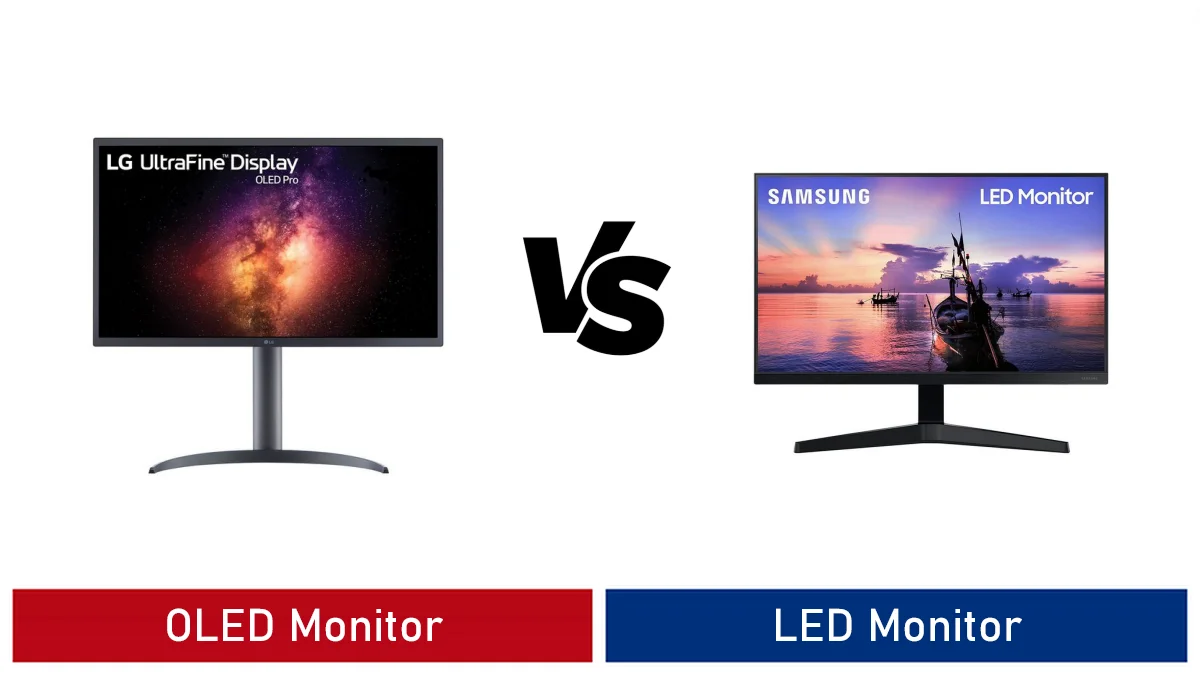 oled-vs-led-monitor
oled-vs-led-monitor
OLED vs LED Monitors – Choosing the right monitor for your computing needs is crucial, as it significantly impacts your viewing experience, whether you’re working, gaming, or consuming media content.
When it comes to display technologies, two options often stand out: OLED (Organic Light Emitting Diode) and LED (Light Emitting Diode) monitors.
In this comprehensive guide, we’ll delve into the differences between OLED and LED monitors to help you make an informed decision.
Contents
1. OLED Monitors
1.1 What is OLED?
OLED stands for Organic Light Emitting Diode. Unlike traditional LED monitors, where the backlight shines through liquid crystal displays (LCDs),
OLED monitors use organic compounds that emit light when an electric current is applied. Each pixel in an OLED display is self-emissive, meaning it can emit its own light independently.
1.2 Advantages of OLED Monitors
Table 1: OLED vs LED Monitors – Advantages
| Aspect | OLED Monitors | LED Monitors |
|---|---|---|
| Contrast Ratio | Perfect blacks and infinite contrast | Lower contrast ratios |
| Color Accuracy | Exceptional color accuracy | Good color accuracy |
| Response Time | Fast response times and reduced motion blur | Slightly slower response times |
| Energy Efficiency | Energy-efficient due to pixel-level lighting control | Energy-efficient due to LED backlight |
1. Perfect Blacks and Infinite Contrast
One of the standout features of OLED monitors is their ability to achieve perfect blacks and an infinite contrast ratio.
In an OLED display, when a pixel is turned off, it emits no light at all, resulting in true black levels. This creates stunning contrast, making colors and images pop with unmatched vibrancy.
2. Exceptional Color Accuracy
OLED monitors are known for their exceptional color accuracy and vibrancy. They can reproduce a wide color gamut, which is especially important for professionals in graphic design, photo editing, and video production. Colors appear rich, true-to-life, and highly detailed.
3. Fast Response Times and Reduced Motion Blur
OLED monitors offer fast response times, which is beneficial for gamers and those who watch fast-paced content.
Reduced motion blur enhances the overall viewing experience, making fast-moving images appear sharp and clear.
4. Energy Efficiency
OLED monitors are energy-efficient, thanks to their pixel-level lighting control. When displaying dark content or black backgrounds, individual pixels can be turned off completely, saving power.
This is particularly advantageous for those concerned about energy consumption.
1.3 OLED Monitor Considerations
Despite their impressive advantages, OLED monitors come with some considerations:
Table 2: OLED Monitor Considerations
| Aspect | OLED Monitors |
|---|---|
| Risk of Burn-In | Possible risk, especially with static content |
| Price | Generally higher cost compared to LED monitors |
| Screen Sizes | Limited availability in larger sizes |
1. Risk of Burn-In
One potential downside of OLED technology is the risk of burn-in, where static images or elements displayed for extended periods can leave permanent ghosting on the screen.
However, modern OLED monitors have implemented technologies to mitigate this risk, and it’s less of a concern for everyday use.
2. Price
OLED monitors are typically more expensive than their LED counterparts. If you’re on a tight budget, this might influence your decision.
3. Limited Screen Sizes
OLED monitors are less common in larger sizes, which may limit your choices if you require a massive display.
2. LED Monitors
2.1 What is LED?
LED stands for Light Emitting Diode. LED monitors use LED backlighting technology to illuminate the liquid crystal displays (LCDs) that form the screen.
There are different types of LED backlighting, including Direct LED, Edge-lit LED, and Mini-LED, each with its characteristics.
2.2 Advantages of LED Monitors
Table 3: LED vs OLED Monitors – Advantages
| Aspect | LED Monitors | OLED Monitors |
|---|---|---|
| Price | Generally more affordable | Higher cost compared to LED |
| Lifespan | Longer lifespan and reduced risk of burn-in | Potential risk of burn-in |
| Screen Sizes | Wider availability in various screen sizes | Limited availability in larger sizes |
1. Price
One of the significant advantages of LED monitors is their affordability. LED technology is cost-effective, making LED monitors accessible to a wide range of consumers.
2. Lifespan
LED monitors generally have a longer lifespan and are less prone to burn-in compared to OLED monitors.
This durability can be a significant factor for users looking for a long-term investment.
3. Screen Sizes
LED monitors are available in a wide range of screen sizes, from compact displays for office use to massive screens for immersive gaming or media consumption.
2.3 LED Monitor Considerations
While LED monitors offer several benefits, they also come with some considerations:
Table 4: LED Monitor Considerations
| Aspect | LED Monitors |
|---|---|
| Lower Contrast Ratios | Inferior contrast compared to OLED |
| Limited Ability to Achieve True Blacks | Challenged in displaying true black levels |
| Differences in Color Accuracy | May have slightly lower color accuracy compared to OLED |
1. Lower Contrast Ratios
LED monitors generally have lower contrast ratios compared to OLED displays. This means they might struggle to display deep blacks and achieve the same level of contrast.
2. Limited Ability to Achieve True Blacks
Unlike OLED, where pixels can be turned off completely for true black levels, LED monitors rely on backlighting, which can lead to a lack of true blacks.
3. Differences in Color Accuracy
While LED monitors can offer good color accuracy, they may not reach the same level of color vibrancy and precision as OLED monitors.
3. Comparison Table: OLED and LED Monitors
Here’s a comparison table summarizing the key differences between OLED and LED monitors:
| Aspect | OLED Monitors | LED Monitors |
|---|---|---|
| Display Technology | Organic Light Emitting Diode | Light Emitting Diode |
| Pixel Technology | Self-emissive | Backlit LCD |
| Contrast Ratio | Perfect blacks, infinite contrast | Lower contrast ratios |
| Color Accuracy | Exceptional color accuracy, wide gamut | Good color accuracy |
| Response Time | Fast response times, reduced motion blur | Slightly slower response times |
| Energy Efficiency | Energy-efficient due to pixel-level lighting control | Energy-efficient due to LED backlight |
| Price | Generally higher cost | Generally more affordable |
| Lifespan | Potential risk of burn-in, shorter lifespan | Longer lifespan, reduced burn-in risk |
| Screen Sizes | Limited availability in larger sizes | Wider availability in various sizes |
| Burn-In Risk | Possible risk with static content | Minimal risk |
| Achieving True Blacks | Can achieve true blacks | Challenged in displaying true black levels |
| Color Vibrancy and Precision | Exceptional color vibrancy and precision | Good color accuracy but may lack vibrancy |
| Suitable For | Gaming, media consumption, professional work | General computing, budget-conscious buyers |
| Availability | Available but less common in larger sizes | Widely available in various sizes |
This table provides a concise overview of the primary differences between OLED and LED monitors, helping users make an informed decision based on their specific needs and preferences.
4. Choosing Between OLED and LED Monitors
1. Gaming and Media Consumption
If you’re a gamer or a media enthusiast seeking stunning visuals, OLED monitors could be the way to go.
Their perfect blacks, vibrant colors, and fast response times create an immersive experience.
2. Professional Use
Professionals in fields like graphic design, photo editing, and video production often benefit from the exceptional color accuracy and contrast offered by OLED monitors.
However, LED monitors with good color accuracy may suffice for many professional tasks.
3. Budget Considerations
Budget-conscious buyers might lean towards LED monitors due to their affordability. LED monitors offer a reasonable balance between performance and cost.
5. Real-World Examples: OLED and LED Monitors
Let’s provide some real-world examples to illustrate when you might prefer OLED or LED monitors:
Scenario 1: Graphic Design Studio
Choice: OLED Monitor
In a graphic design studio, where color accuracy and vibrancy are paramount, an OLED monitor would be the preferred choice.
OLED’s exceptional color accuracy and ability to display a wide color gamut ensure that designers can work with precision and confidence, accurately representing colors in their projects.
The perfect blacks and infinite contrast also make images and graphics stand out.
Scenario 2: Competitive Gaming Setup
Choice: OLED Monitor
For a competitive gaming setup, where fast response times and reduced motion blur are essential, an OLED monitor would excel.
OLED’s fast response times provide a competitive edge by ensuring that fast-paced games display sharp and clear images, reducing ghosting effects.
Additionally, the perfect blacks and vibrant colors contribute to an immersive gaming experience.
Scenario 3: Office Environment
Choice: LED Monitor
In a typical office environment, LED monitors are a practical choice. They offer good color accuracy for everyday tasks, and their more affordable price point makes them suitable for businesses looking to equip multiple workstations.
LED monitors also come in a wide range of screen sizes, allowing offices to choose displays that fit their available space.
Scenario 4: Home Entertainment
Choice: OLED Monitor
For a home entertainment setup where movie nights and immersive media experiences are common, an OLED monitor’s ability to achieve perfect blacks and infinite contrast is ideal.
It enhances the overall viewing experience, making movies and TV shows come to life with vibrant colors and deep blacks.
OLED is a fantastic choice for creating a home theater atmosphere.
Scenario 5: Tight Budget
Choice: LED Monitor
When budget constraints are a primary concern, LED monitors offer an affordable solution without compromising on basic display quality.
LED monitors provide good color accuracy for general use and are a sensible choice for students, families, or anyone seeking a cost-effective display option.
These real-world scenarios demonstrate how the choice between OLED and LED monitors depends on specific use cases, priorities, and budgets.
Whether you’re a professional in need of precise color accuracy or a casual user looking for an affordable option, there’s a monitor type that suits your requirements.
6. Future Developments
It’s worth noting that both OLED and LED technologies continue to advance. Manufacturers are constantly working on improving OLED screen lifespan and reducing the risk of burn-in.
LED monitors are benefiting from advancements in backlighting technologies, such as Mini-LED, which aims to enhance contrast and color accuracy.
7. Conclusion
In conclusion, choosing between OLED and LED monitors ultimately depends on your specific needs and priorities.
OLED monitors excel in providing perfect blacks, exceptional color accuracy, and fast response times, making them ideal for gaming, media consumption, and professional work.
LED monitors, on the other hand, offer affordability, longer lifespan, and wider availability in various sizes.
Consider your budget, use cases, and preferences when making your monitor selection. Whether you opt for the rich, vibrant colors of OLED or the affordability of LED, you’re sure to find a display that enhances your computing experience.
8. OLED vs LED Monitors FAQs
What is the main difference between OLED and LED monitors?
The primary difference between OLED (Organic Light-Emitting Diode) and LED (Light-Emitting Diode) monitors lies in their display technology. OLED monitors use organic compounds that emit light when an electric current is applied to them, while LED monitors use a backlight behind an LCD (Liquid Crystal Display) panel to create images.
Which one offers better picture quality, OLED or LED?
OLED monitors typically offer superior picture quality compared to LED monitors.
OLED displays have perfect black levels, infinite contrast ratios, vibrant colors, and faster response times, resulting in more vibrant and true-to-life visuals.
Are OLED monitors more expensive than LED monitors?
Yes, OLED monitors are generally more expensive than LED monitors.
The manufacturing process for OLED displays is complex and costly, which reflects in their higher price tag.
Which type of monitor is better for gaming, OLED, or LED?
OLED monitors are often preferred for gaming due to their fast response times, high refresh rates, and exceptional picture quality.
However, LED monitors can also be suitable for gaming, especially those with high refresh rates and low input lag.
Are there any downsides to OLED monitors?
While OLED monitors offer outstanding picture quality, they can be susceptible to burn-in, where static images displayed for extended periods may leave a permanent ghost image.
Additionally, OLED monitors tend to be more expensive and may have a shorter lifespan compared to LED monitors.
|
Related Tags
Oled vs led monitors which is better, Oled vs led monitors vs qled, Oled vs led monitors for gaming, oled vs led laptop, difference between led and oled and qled, oled vs qled, oled vs lcd iphone, oled vs led for gaming
Last update on 2024-05-11 at 13:16 / Affiliate links / Images from Amazon Product Advertising API













